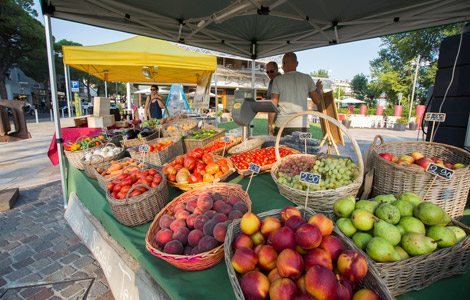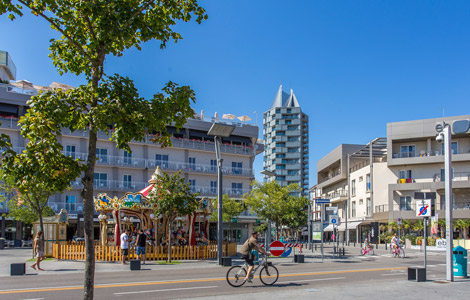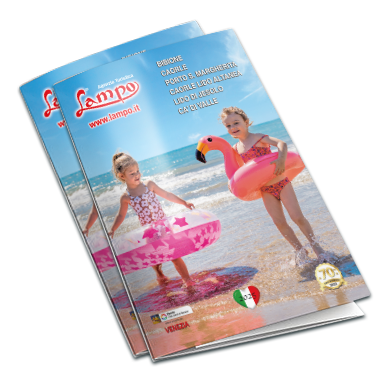Jesolo is a town on the Veneto coast that’s famous all over Europe for its vast beach covered with golden sand, as well as its crystal-clear water and its vibrant lido. Tourists flock there to stay in the first-rate accommodation, including holiday villages, hotels and holiday homes.
Jesolo Lido is in an outstanding location by the Adriatic Sea. It’s just a few miles from Venice, which is quick and easy to reach by boat from Punta Sabbioni.Jesolo’shistoric centre and town hall are just five kilometres from Jesolo Lido, where all of the tourist facilities by the beach and the sea are found.
As well as a warm welcome from the Agenzia Lampo staff, in Jesolo you’ll be greeted by spellbindingly beautiful natural scenery just a short distance from the wonders of Venice, which is like nowhere else on Earth. Find the ideal solution for your stay on our website now, or contact us if you have any questions. We’ll be happy to help you choose the perfect place for you.
First, though, we’d like to tell you about the history of Jesolo. There’s something unique and mysterious about the legends and popular beliefs intertwined with big historical events.
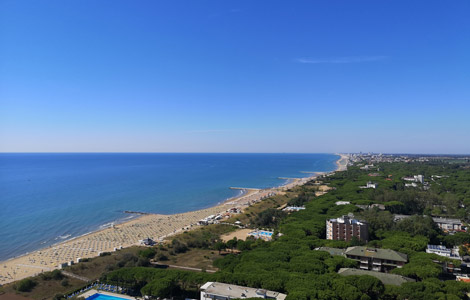
Why is it called Jesolo?
In ancient times, Jesolo was known as Equilium (“Horse Town”) because the Veneti from the area were renowned horse breeders. Subsequently, Jesolo’s location meant that it played a strategic role in Venetian trade. From 500 to 1930, it was known as Cava Zuccherina. The name came from a canal (or “Cava” in Venetian) built by an engineer from Venice called Alvise Zucharin.
Following the destruction caused by the First World War, a revival began in 1930. There were land reclamation schemes and determined efforts to give the local people a more prosperous future. With this in mind, the decision was made to replace the name “Cava Zuccherina”, which by that time conjured up images of marshland and malaria. The choice of the name Jesolo met with widespread acclaim among the local people, who were gradually starting to grasp and appreciate the advantages of being by the sea and the health benefits it can bring. The name Jesolo actually comes from Equilium. It underwent various changes over the years and became Equilio, Esolo, Exulo, Iesulo, Giesolo and Jexollo at different times, before taking on its current form.
The history of Jesolo: from its origins to the present day
Over the centuries, a key part in the history of this stretch of land has been played by its physical characteristics. It brings together farmland and inland woods with the Adriatic Sea, lagoons, sandbanks, and a multitude of little islands that have been created over the years by the water flowing in the rivers.Among the most notable features of Lido di Jesolo are its extensive pedestrian zone and its countless wooden groynes. The latter were built in the 1980s to prevent erosion and aid beach nourishment. They’re made out of concrete and have wood on top, where people step when they walk along them.These wooden walkways have proved to be popular spots for sunbathing while enjoying the sea breeze, but it’s important to note that diving off them is strictly forbidden. This is because currents are constantly moving the sand on the seabed, resulting in dangerous conditions.
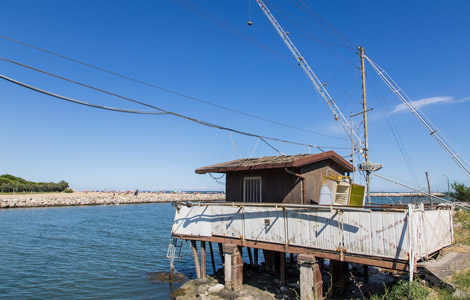
Jesolo’s ancient roots
The first settlements in these alluvial areas were conquered in around 600 AD by the Lombards, who invaded the zone and also a number of inland towns. Following the barbarian invasions, various groups of people fled from inland towns and cities and sought refuge on the islands by the sea. This breathed new life into Jesolo and boosted its population. It slowly developed into a strategic hub for maritime trade between Italian and Byzantine markets.
Unfortunately, life in this part of the world was made increasingly difficult and precarious by a series of floods, as well as a tsunami in 1110. Eventually, several Venetian nobles who owned various pieces of land settled in the area. They built a church and a new village sprang up around it, providing the inhabitants with a fresh nucleus and enabling them and their families to focus on farming livestock and the land once again.
The Middle Ages and Venetian rule over Jesolo
A number of Venetian landowners began significant land reclamation schemes in the area. This required the hiring of new workers, who were subsequently employed to farm the reclaimed land. It paved the way to considerable development, a big population increase, the construction of churches and the establishment of a diocese. The Soranzo family from Venice took a number of measures to prevent flood damage over the years. Their efforts brought new people to the area, along with fresh trading opportunities and a boom in livestock breeding, which had always been an important way of making a living there.
Nonetheless, the zone was destined to suffer yet more big setbacks. In 1917, the Austro-Hungarian invasion and fierce fighting during the First World War led to huge loss of life and another reversal in Jesolo’s fortunes.
Jesolo’s 20th century revival
After the war, in 1930 the town changed its name from Cava Zuccherina to Jesolo. Land reclamation began again on a big scale, with considerable development of areas for agriculture: new wealth was generated by expanses of fields of wheat, maize, sugar beet, fodder crops and vineyards.
In addition, various trades developed to cater to the needs of the people living in the area. Meanwhile, the locals began to head down to the Lido by cart or bike in order to enjoy the recreational opportunities and health benefits presented by the beach.
As the years went by, the first beach establishments appeared. Slowly but surely, they were followed by more and more hotels, holiday homes and other buildings. They all came together to form the popular, modern resort everyone knows today, where tourists get a warm welcome and can count on exceptional services and facilities.
Jesolo: fascinating facts and old traditions and legends
On the Jesolo coat of arms is a winged dragon with a horse’s head. It’s thought that the ancient name Equilium is behind the equine feature, while the “dragon” actually has nothing to do with medieval witches or dragons. It probably comes from the old Veneto term “trar”, which means “to hunt”.Still today, some older people in Veneto use the expression “vae a trae”, which means “I’m going hunting”. This may have gradually shifted in pronunciation and meaning, leading to the area being known as “Valle del Traco”, then “Valle del Draco” and finally “Valle del Drago” (“Dragon Wetlands”). After all, the fog at night in the wetlands where Venetian nobles went hunting and fishing probably gave rise to all sorts of stories about ghosts and mythological creatures.
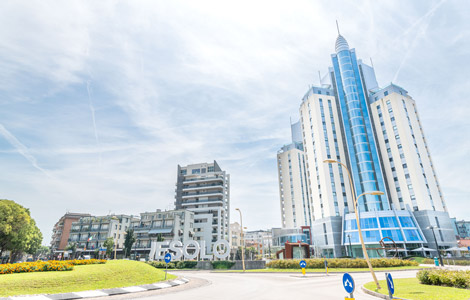
The legend of Christ the King
Legend has it that one day in the 17th century, a farmer was ploughing a field near Jesolo with oxen when the animals suddenly came to a halt and nothing he could do would get them moving again, so he went to see what the problem was. On the ground in front of the oxen, he found a crucifix. He carefully picked it up and took it to the parish priest, who put it in a cupboard in the vestry.
The following morning, the farmer went back to the field to carry on ploughing, but the oxen stopped in exactly the same place and he simply couldn’t get them moving again. He went to see what was holding things up and he was amazed to find the same effigy of Christ on the ground. He took it back to the priest, who opened the cupboard to put it away and was astonished to find that the crucifix from the previous day was no longer there.
The people of the town immediately started calling it a miracle.The Zen family – who owned a number of pieces of land in the area – had a little church built on the exact spot where the crucifix was found.
This original construction was later renovated to give us the church dedicated to Christ the King that can be seen today. It stands outside Cavallino, on private land belonging to the Campagner family. Once a year, on 1 May, mass is held in the chapel. During the proceedings, the priest blesses the village and takes the crucifix to the bank of the Sile river.
The legend of the Embroidery in the Sea
Another fascinating tale concerns the nearby island of Burano. It’s said that mermaids out at sea tried to lure a young fisherman, but he remained faithful to his sweetheart, resisted temptation and returned to the harbour.
The queen of the mermaids was so impressed that with a splash of her tail she turned the wake behind the boat into a beautiful wedding veil, which everyone admired when they got married. The women of the island immediately began trying to make similar ones with fine white threads, leading to the development of the traditional Burano lace that’s so famous across the globe.
The Devil’s Bridge on Torcello
Another island near Jesolo is Torcello, where there’s a bridge without parapets known as the “Devil’s Bridge”.
It’s thought that it might have got its moniker from a local family whose surname was “Diavoli”, but there’s also a much more romanticized tale about a Venetian maiden who fell in love with an Austrian officer. It goes without saying that the girl’s family weren’t happy about it and they tried to split them up. News reached the young women that her sweetheart had died. Now that she couldn’t be with him, she decided to take her own life, but then a friend advised her to ask a witch for help.
The witch made a deal with the Devil to bring the man back in exchange for the souls of seven children. The sorceress gave the girl a gold coin and a lit candle to take across the bridge. The Devil then appeared, took the coin and handed over the young Austrian officer. When the candle went out, the young couple saw the road to happiness appear.
It was then up to the witch to pay off the debt by taking the children’s souls across the bridge on 24 December, but she was killed on her way home. On Christmas Eve every year since then, the Devil has appeared on the bridge in the form of a black cat to claim what he’s still owed. Although it’s only a story, it sends shivers down your spine!
Festivals and celebrations in Jesolo
You never get bored in Jesolo! As well as the sun, sea and sand, there are all sorts of shows, events and celebrations to enjoy. Here’s a selection of them:
Weekly market in Jesolo town centre
Every Friday morning until 1:00 pm, there’s a weekly market in Jesolo’s historic centre, with stalls selling fruit, vegetables, cheese, deli meats, clothing, household goods, toys, gifts and much more. You can buy some great things there, so don’t miss it!
Jesolo Vintage Village
In May for the last two years, the craziest and most colourful village around has been in Piazza Mazzini and Piazza Aurora, where vintage clothing, accessories, records and other items have been on display.
Don’t miss the chance to snap up something original or a rare creation you’ve always wanted!
Equilium in Festa
Starting in mid-June, Jesolo’s historic centre hosts two weeks of festivities dedicated to the town’s patron saint, John the Baptist. As well as religious celebrations, there are shows, plays, food and wine stands, kayak trips along the Caigo canal, entertainment for all the family, traditional games, an antiques fair, the Palio delle Contrade (a competition between different districts of the town) and fireworks to bring the curtain down on it all.
Wine Festival
If you’re a wine lover, Piazza Milano is the place to be in late September because you’ll have the chance to taste a selection of fine wines accompanied by Veneto culinary delights.
Savour a refined Valpolicella, polished Custoza, sparkling Prosecco or rich Amarone to the sound of live music every evening.
Festa del Sugaman
With a name that means “Towel Party”, for years now this event in late September has officially marked the end of the summer. Everyone is welcome in Piazza Milano, where they’ll find a packed line-up of music and entertainment, as well as food, beverages, fair rides and sweets. A great time is guaranteed for young and old alike.
Have these stories, legends and traditions from Jesolo left you eager for more?
If you’d like to visit Jesolo and the natural environment all around it, book a holiday now. You can have fun while also unwinding and taking home lots of wonderful memories about incredible experiences. Are you looking for a holiday home or village in Jesolo? Go to lampo.it to find the best offers.
Contact us if you have any questions and we’ll be happy to help you choose. For more interesting posts like this one, follow our blog.
